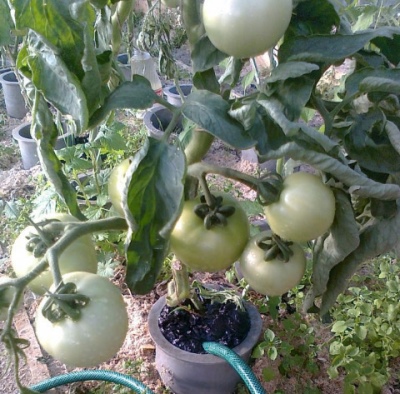
- Authors: B. V. Monsanto Holland (Netherlands)
- Year of approval: 2007
- Name synonyms: Florida 47 R
- Category: hybrid
- Growth type: determinant
- Appointment: fresh consumption, for juice, for ketchup and tomato paste
- Ripening period: mid-early
- Growing conditions: for open ground, for film greenhouses
- Bush height, cm: 70
- Stem: powerful
Inexperienced summer residents, as well as gardeners who do not have free time to care for tomatoes in the garden, are recommended to grow unpretentious varieties that give excellent yields. These include the hybrid variety Florida 47, which grows both in unprotected soil and in a film greenhouse.
Breeding history
A hybrid variety Florida 47 was created by a group of Dutch breeders B. V. Monsanto Holland in 2005. The nightshade crop is allowed for use and entered in the register of approved varieties in 2007. The tomato is zoned in all regions of Russia. Tomatoes can be grown both in garden beds and under a film cover.
Description of the variety
Florida 47 is a stunted plant of the determinant type. The bushes stretch up to 70 cm in height. The plant is characterized by strong stems, a developed root system, which goes deep into the soil by 1.50 m, good thickening with dark green leaves with a wide plate, intermediate inflorescences. 3-5 berries are formed in each fruit cluster. During the growing period, it is recommended to form bushes in 1-2 stems, which will improve the yield rate, and also be sure to tie up, since weighty fruits can break off the branches of the bushes. Passing is carried out up to the first fruit cluster.
The purpose of tomatoes is universal. They are eaten fresh, pickled and canned. In addition, tomatoes are processed into dressings and drinks.
The main qualities of the fruit
Dutch tomatoes are large-fruited nightshades. On average, a weighty tomato grows to 181-210 grams. The shape of the fruit is flat-round, with slight ribbing. When fully ripe, the vegetable is evenly colored with a bright red color. At the stage of technical maturity, the berries are green. The vegetable peel is dense and shiny, perfectly smooth. Tomatoes are resistant to cracking, well transported and stored for a long time (up to 2-3 months). The advantage is the evenness of the berries, due to which they acquire a good presentation.
Taste characteristics
Florida 47 tomato tastes good. The flesh of the vegetable is fleshy, moderately dense, juicy, with small seeds that are not felt when eaten. The taste of tomatoes is classic - sweet and sour, balanced, complemented by a rich spicy aroma.
Ripening and fruiting
The Dutch tomato is a medium early tomato class. From the moment of mass germination of seedlings to ripe berries on the bushes, 110-115 days pass. Tomatoes ripen gradually, which allows fresh tomatoes to be removed for a long time. The peak of fruiting is somewhat stretched - it falls in July-August. The timing of mass ripening may shift slightly due to the climatic conditions of the region.
Yield
The yield indicators for this species are excellent. If the minimum agrotechnical recommendations are observed, 4.7-5 kg of tomatoes can be harvested per 1 m2. In greenhouse conditions, the yield can be higher.
The timing of planting seedlings and planting in the ground
The plant is grown through seedlings. Sowing seeds for seedlings is recommended in March. The seed must be sorted out, sifting out unusable, disinfected and treated with growth stimulants. Subject to the correct growing conditions (20-22 degrees indoors and good lighting), germination of sprouts occurs on 6-8 days.
When 3 real leaves appear on the bushes, and the height is 5-7 cm, they should be dived (individual seating). When planting, it is necessary to pinch off the tip of the root, which contributes to the formation of a branched root system. After 10-14 days, the bushes need to be fertilized with an organic complex. A week before the transfer, the bushes are hardened by exposing them to fresh air for 40-60 minutes.
Seedlings can be planted in a permanent place of growth in the period from the last decade of April to the end of May.

Growing tomato seedlings is an extremely important process, because it largely depends on whether the gardener can harvest at all. All aspects must be taken into account, from seedbed preparation to planting in the ground.
Landing scheme
The density of the bushes, as well as the planting pattern, are very important. On 1 m2, you can arrange from 3 to 5 bushes, which will provide air and sun access to each plant. The recommended scheme for planting is 40x60 cm.

Growing and caring
The variety is very picky about the soil. The soil should be chosen loose, breathable, fertile and moderately moist. The best precursors for tomatoes are onions and early cabbage.
When growing a culture, do not forget about elementary care: watering, fertilizing, weeding and loosening the soil, garter and forming bushes, as well as protection from viruses and pests.




A plant needs different micronutrients at each stage of growth. All fertilizers can be divided into two groups: mineral and organic. Folk remedies are often used: iodine, yeast, bird droppings, eggshells.
It is important to observe the rate and period of feeding. This also applies to folk remedies and organic fertilizers.
Disease and pest resistance
The variety has genetic resistance to many diseases typical of nightshade crops. Tomatoes are not susceptible to fusarium wilt and verticillosis. Due to early maturity, tomatoes leave phytophthora. Spraying with insecticides will provide protection against harmful insects.


Resistant to adverse weather conditions
High stress resistance allows the plant to tolerate temperature extremes, prolonged heat and short drought.

























































































